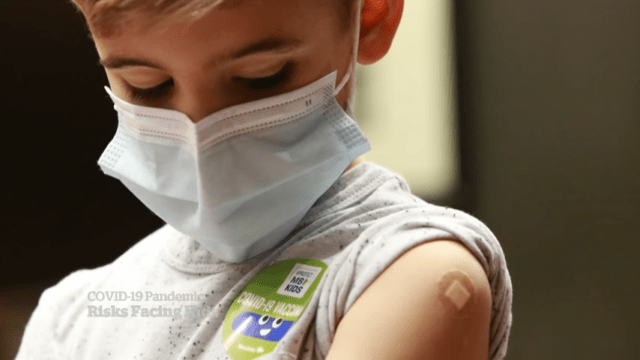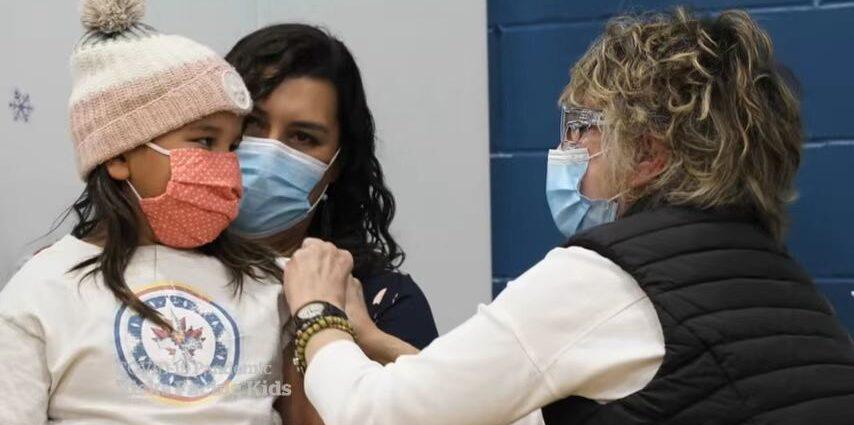In most parts of the country, fewer than half of Canadian children ages five to eleven have received their first Covid vaccine dose, but there are three places leading the charge with high vaccination rates.
Newfoundland and Labrador is given first doses to more than 74 percent of all children age five to eleven. Nova Scotia is second, with 64 percent of kids having received the first dose, while Quebec not far behind, with just 61 percent.
Yesterday, CBC interiewed doctors in those three provinces. Dr. Earl Rubin is the director of infectious diseases at the Montreal children’s hospital. Dr. Katrina Hurley is head of pediatric emergency medicine at the IWK health center in Halifax, and Dr. Natalie Bridge is a pediatric infectious diseases physician with eastern health and St. John’s in Newfoundland and Labrador.

In terms of children with covid at IWK health center, Dr. Katrina Hurley said: “We certainly have a number of children who come and visit the emergency department after testing positive for Covid at home. We aren’t seeing many children who require admission to hospital at this point from their Covid illness, so some of these children come in with a headache or fever, and we also have seen children present with simply vomiting. And this time around, we’ve seen more children with croup than we’ve seen in previous waves.”
At Dr. Earl Rubin’s hospital in Montreal, he said: “In terms of what’s seen in the emerge, it’s like doctor Hurley said, in those who are coming in at any one point in time since Omicron has hit, so since mid December, we’ve had anywhere between five and ten kids admitted who are covid positive. They’re not the same five or ten. There’s high turnover. What’s really interesting is about half of those kids are not admitted because they have Covid. They’re found to be Covid positive. They’re admitted for elective surgery, a trauma, something like that. And then we test everybody before admission, and we find that they’re Covid positive. So it’s only half that are being admitted because of Covid.”
Dr. Natalie Bridge is not seeing really clear patterns in St. John’s, because she doesn’t have a lot of pediatric Covid admission.
As Dr. Natalie Bridge said: “To date for the whole Covid pandemic, we’ve only seen a six pediatric admissions in our province. Five of those have been since the appearance of Omicron at the end of December 2021. So I can’t really get into any sort of patterns of symptoms that we’ve seen it in admitted patients, because we had so few. Our Omicron wave sort of coincided with the closure of schools for the holiday season. So in that sense, I think that probably prevented some pediatric admissions down the road.”

When asked about the difference between children being vaccinated and unvaccinated, Dr. Earl Rubin answered:
“It is clear those that are admitted for Covid, who are a little bit sicker, tend not to be vaccinated. However, about half of the admission are not even vaccine eligible, because they are under the age of five. So when you look for five and above those who are more significantly ill because of covid and not being admitted for other reasons, they tend to be non vaccinated.”
When talked about why Newfoundland and Labrador’s kids between five and eleven have higher vaccination rates, Dr. Natalie Bridge said she thinks there are 3 reasons for that.
As Dr. Natalie Bridge said: “The first reason is Newfoundland and Labrador has a culture of vaccine acceptance. Because we’ve had decades of a really strong public health nursing system, that’s primarily given childhood vaccines, and so there’s been a lot of confidence in childhood vaccines. I think that’s the first part of the equation that vaccines have traditionally been more acceptable. Second, I think that our population has a lot of trust in our leadership. Our chief medical officer of health, doctor fitzgerald has managed the pandemic for the past two years very steadily and people trust doctor fitzgerald and her team. Thirdly, the leadership made it easy for people to get their kids vaccinated. So they gave people options of either taking their kids to mass vaccination clinics, or they give parents and caregivers the option of getting the kids vaccinated in the school system. So I think that the combination of acceptability and accessibility really helped get the momentum going in Newfoundland and Labrador.”

When asked about if there should be a campaign to increase the number of kids who do get vaccinated, Dr. Earl Rubin answered:
”Absolutely, where the campaign really needs to spearhead is from the primary caregiver for that family, a lot of parents will turn to their pediatricians say, what do you recommend? The question that all often get is, what did you do for your kids, and if they hear that their physician is vaccinating their own children, they are much more open to the discussion. So yes, public health put it out there. But what’s more important is the people who know the patient and the family, and to sit down and listen to what their concerns truly are and address them, and don’t judge them if they’re nervous, or they don’t want, but to listen and to be able to address the concerns they may have.”
Dr. Katrina Hurley also answered that “I would say it’s interesting the way it comes up, because I routinely would ask people if their vaccinations are up to date. And I usually meeting all those other vaccinations, but now when I ask that question, there’s a presumption that I’m speaking only about Covid. I think it’s the vaccination that is top of mind for most people that are coming in. And I haven’t seen that sort of reaction with influenza vaccinations, for example, or with any other vaccine. And I agree with what Dr. Ruben had just said is that people ask what are you doing and how would you respond. So I try to answer both as a physician and as a parent.”

Last but not least, the really important point is to make these vaccinations as accessible as possible.
As Dr. Natalie Bridge said: “The leadership and public health leaders need to take a look at their populations and figure out, how can we make this vaccine as easy as possible for families to access. And so some in our case, it was giving families options in schools and mass vaccine clinics. It could also be different in other places. Overall, I think accessibility is one of the major driving factors here.”
Resource: CBC News

